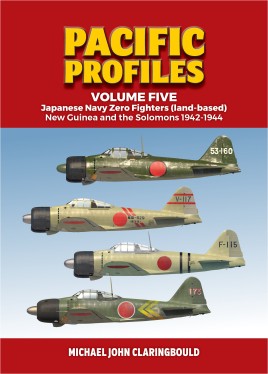Japanese Naval Zero Fighters (land-based) New Guinea and The Solomons 1942-1044
About the Author
Michael John Claringbould was raised in Papua New Guinea, where he developed his fascination for the Pacific air war. During a career in the Australian foreign service he undertook postings across Oceania and the Pacific. He is author of three books on the USAAF Fifth Air Force: The Forgotten Fifth, Forty of the Fifth, and Black Sunday, and co-author of Eagles of the Southern Sky, a history of the Tainan Kaigun Kokutai in New Guinea, and The Roarin 20s, a unit history of the USAAF 312th Bombardment Group. Michael is also an associate editor of the historical aviation magazine Flightpath, to which he has been contributing articles for 18 years. He now lives in Australia.
Introduction
In this section the author offers some brief insight into Japanese Naval aircraft markings, marking colors, IJN rank structures, tail codes, aircraft overall paint color, and Zero models. There is also a paragraph on primer color and paint application, including several FS numbers for the paint colors used.
The white surround on the Hinomaus was to be painted out to avoid "misidentification as enemy fighters" based on an instruction to field units issued on August 27, 1943. This explains the back/green outlines appearing on hinomarus.
Contents
Technical Notes: Zero Models in the South Seas. This section addresses the Zero models involved in combat in the New Guinea and Solomons area.
Page 13 has images of the fuselage factory stencils as applied by both Mitsubishi and Nakajima. Each stencil has English translations. Page 14 goes on to show top-of-wing and spinner stencil locations and translations.
Glossary & Abbreviations: Here the various Japanese terms are explained.
Reviewer's Note: The following chapters each follow a common format, and rather than repeat that content for each chapter I offer the following. Each chapter includes some historical background for each Kokutai (IJN air group) , unit markings are discussed, several black-and-white and sometimes color period images are provided, along with left side profiles of various Zero models with descriptive text for each profile.
- Chapter 1 - No.2 Kokutai. Page 21 has an image of a Japanese ground crew overhauling a Zero's engine.
- Chapter 2 - No.3 Kokutai. Page 26 has a nice image of a parked Zero with over-painted fuselage band marking clearly shown. This image is complimented by a color profile on page 28. There is also a close up color image on the same page of a wreaked Zero's fuselage with areas of the original red primer showing through as well as the hokoku ("service to the country" inscription.
- Chapter 3 - No.4 Kokutai (Fighter Wing). Pages 32 and 35 have several black-and-white images of wreaked Zeros.
- Chapter 4 - No.6 Kokutai. Page 43 has a nice 3/4 right side front view of a green mottled Zero in flight.
- Chapter 5 - Kanoya Kokutai. (Refer to reviewer's note above).
- Chapter 6 - Tainan Kokutai. Pages 54 and 55 have several more images of wrecked Zeros.
- Chapter 7 - No.201 Kokutai. (Refer to reviewer's note above).
- Chapter 8 - No.204 Kokutai.Page 77 has a color image taken in 2020 of a wrecked fuselage.
- Chapter 9 - No.251 Kokutai. (Refer to reviewer's note above).
- Chapter 10 - No.252 Kokutai. (Refer to reviewer's note above).
- Chapter 11 - No.253 Kokutai. (Refer to reviewer's note above).
- Chapter 12 - No.582 Kokutai. (Refer to reviewer's note above).
- Chapter 13 - Rabaul Air Force. Page 108 has an in-flight image of a Zero with the hinomaru's white surround over-painted a black/green color. Page 111 has an exceptionally clear color image of late model airframes in a dump. The aircraft are all painted green, with areas of paint chipping and peeling. The author notes that often the green paint would become brown with exposure to the elements.
- Sources - General.
- Index of Names.
- Conclusion
I found this publication to be an interesting and informative read, offering information on paint colors used on the Pacific Zeros as well as explanations of the various stencil markings. The black and white images, while many are not particularly sharp or clear, do include notes to explain the content. There are a few period color images, plus several very nice artwork images included.
My thanks to IPMS/USA and Casemate Publishers for the opportunity to review this publication. If you are interested in The Zero, this publication will offer some valuable information without going into great detail. Recommended.









Comments
Add new comment
This site is protected by reCAPTCHA and the Google Privacy Policy and Terms of Service apply.
Similar Reviews